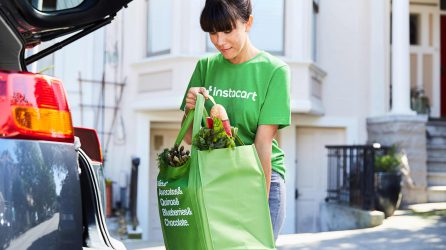Quick commerce: what it is and why CPG brands should care

Presented by:
Stephanie Rubin — 2022
A few weeks ago, as our North America team came together in New York City for our first face-to-face meeting since the start of the pandemic, we decided to embark on a lunchtime challenge. Could we find something to eat using a quick-commerce app? And how long would it really take for our lunch to be delivered?
We wanted to immerse ourselves in quick commerce because it’s one of the hottest areas in grocery right now and an increasingly important topic for our CPG clients. Global investors poured nearly $20 billion into food and meal delivery services in 2021, with a large chunk going to operators promising super-fast delivery times. The WSJ estimates that investors have put at least $7 billion into q-commerce startups in recent years.
As a result, grocery delivery within 15 to 20 minutes is fast becoming commonplace in major cities around the globe. In some particularly competitive markets, such as London, several operators now offer 10-minute delivery. And the speeds really have to be experienced to be believed.
For our NYC lunchtime challenge, we ordered groceries from Getir, the Turkish startup that operates in Chicago, Boston, and New York, and 7NOW, the rapid delivery app from 7-Eleven. The results blew us away. The apps are smartly designed, the shopping experience is intuitive and simple, and we had food in our hands literally 15 minutes after placing the order.
The overall quality, too, was impressive. Our lunchtime order with Getir included grapes, which arrived fresh and in perfect condition, far exceeding our expectations of a convenience shop.
All in all, it adds up to a compelling service that is quickly reshaping shopper expectations. So, how can CPG brands ensure they’re well positioned to benefit from the q-commerce boom?
Don’t worry about picking a winner
Right now, lots of CPGs are wondering who is going to be the winner in this space.
It’s a good question. The sheer number of rapid delivery startups can seem more than a little intimidating. Although Gopuff has emerged as an early leader in the US, last year raising $1 billion in fresh funding, it is far from the only show in town. As of early 2022, at least six different startups were offering q-commerce services in New York City, and new trials are being launched all the time.
No CPG wants to miss out on the next big eCommerce opportunity by being timid in the face of this disruption – but nobody wants to throw money at operators doomed to crash and burn, either. After all, there remain big questions about the business and funding models for these services, and whether they can be profitable.
Luckily, you don’t have to choose. The rational approach right now is to keep your options open, and to test and learn as much as possible. Be nimble about your pricing, promotions, and search strategy, and see what works for your brand. Take advantage of the fact that q-commerce startups tend to launch in a few major cities initially. This means the volumes, and the risk to your brand, are low.
Once you’ve tried a few things and developed a feel for different platforms, slowly ramp up your investment. By being agile and quick, you can shift your strategy around as and when the winners emerge – you don’t need to bet big today. At this stage in the q-commerce game, it’s definitely a good idea to have more than one egg in your basket.
Zero in on assortment and availability
Speed is q-commerce’s defining characteristic. It’s a channel that’s much more impulse-driven than classic eCommerce. This creates exciting new opportunities for snacks, candy, gum, and other impulse products.
As I have explored previously, impulse has a tough time online. Without in-store cues at checkout, shoppers are much less likely to add impulse products to their baskets. CPGs and online grocery retailers are trialing new approaches to replicate these cues in an eCommerce setting, but it’s far from a seamless experience at the moment. Impulse remains incredibly hard to tee up online, and nobody has figured out how to do it well yet.
Quick-commerce apps could change this. Thanks to their focus on speed, convenience, and instant shopper gratification, they are a great fit for impulse brands. More than anyone else, CPGs with an impulse portfolio should take a serious look at quick commerce and test and learn as much as possible.
More generally, assortment is key for winning in quick commerce. Brands must understand the shopper missions driving purchases on rapid delivery apps and tailor their assortments accordingly. Pack sizes are an obvious area. Whereas classic eCommerce over-indexes on bigger pack sizes, q-commerce is driven by smaller and snack sizes.
Having a firm handle on your availability is just as important. Recent reports suggesting Gopuff stocks its warehouses with items bought from Instacart to avoid running out of key products show just how important availability is to q-commerce operators. Consumers on these platforms are impatient and will switch to other services if they can’t get what they want right away.
Of course, managing availability isn’t easy at a time when CPGs remain under strain from the global supply chain crisis. But as much as you can, try to get digital shelf data on what you’re selling through these platforms, and make sure your inventory is sent into fulfilment centers with enough time before you run out.
The fundamentals of eCommerce still apply
Finally, don’t lose sight of the basics. Although quick commerce is new and exciting, fundamentally it’s still eCommerce.
The overall shopper insights remain the same, and the dynamics around search and browsing are very similar. As with traditional eCommerce, ‘buy it again’ functionality drives lots of purchases on q-commerce platforms, so getting into shoppers’ baskets early is important.
To do this, you still need to win in search, and you still need to build your content in a way that will help you win in search. Getting in the top five of search is critical, whether you’re on Gopuff or Instacart or any other online grocery app.
Above all, the product quality needs to be right. As those of us who ended up with a less-than-impressive taco during our NYC lunchtime challenge can attest, the experience of using q-commerce can be dazzling. But shoppers will only keep coming back if operators deliver on quality as well as speed.
All the digital Shelf Analytics You Need to Succeed at Speed & Scale
See why world leading brands choose e.fundamentals for actionable digital shelf insights
Request A demoLatest Resources

CommerceIQ Launches Global Retail Ecommerce Management Platform Combining Sales, Supply Chain, Retail Media, and Digital Shelf with e.fundamentals Acquisition
Ecommerce platform enables consumer brands to grow market share profitably in today’s inflationary and supply-constrained environment through intelligent automation, supporting over 450 omnichannel retailers in 41 countries.

e.fundamentals becomes a CommerceIQ company
e.fundamentals has been acquired by CommerceIQ, the leading Retail Ecommerce Management Platform, headquartered in Palo Alto, California. Consumer brands can now harness one global software platform to power profitable market share growth across all major retailers.

5 strategic pricing opportunities CPGs should focus on now
As tensions run high between retailers and suppliers, CPGs need to be smarter than ever about strategic pricing. Here’s how to use digital shelf analytics to hold your own in tough negotiations.

What the smartest CPGs get right about selling on Instacart
This post has been updated and was originally published March 30, 2021. It's time CPGs get ready to win on Instacart. So read and learn: What's all the hype around…

5 optimization tactics to grow digital shelf sales
This post has been updated and was originally published May 14, 2020. Consumer goods companies (CPG) continue to grapple with enormous shifts to the industry as the eCommerce boom continues…

5 tactics to grow online sales for category managers
Category management has changed. We've highlighted the 5 tactics to help you scale your growth on the digital shelf at speed.
View Our Most Popular resources to help you learn and win on the digital shelf.

The Ultimate Guide to Content Management on the Digital Shelf

The Digital Shelf Cast - Listen to our latest episode





